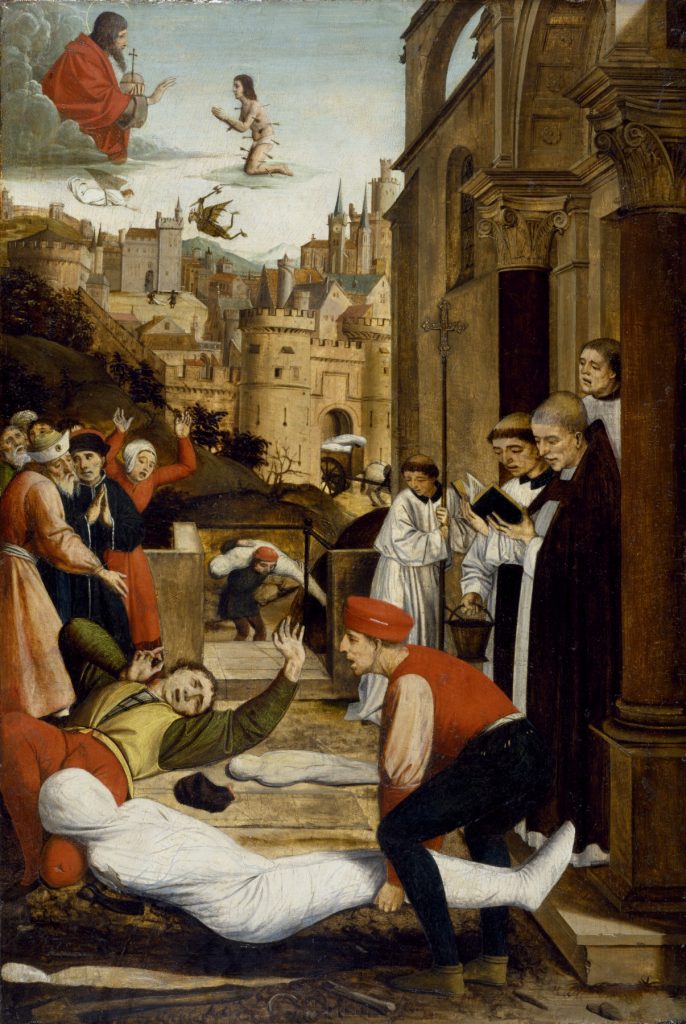There have been many epidemics that have plagued our planet over the last few thousand years; some, however, were more devastating than others. Epidemics often cause major disruptions in a society, besides simply killing people. They affect the amount of people in the workforce, which in turn can disrupt the production of goods and the food supply needed for a society.
The famous Bubonic Plague killed around a third of the population of Europe in the 1300s. The population of Europe in 1340 was about 73.5 million, and the plague affected over 20 million people. Today, Europe’s population is 508,450,856, meaning that if the plague were to have the same effects today as it did in the 1300s, it would kill around 102,000,000 people!1

The Bubonic Plague originated in the fleas carried by rodents like rats, squirrels, and prairie dogs, which transmitted the disease from one to the other. The disease spread from southwestern China to eventually the Black Sea ports of Caffa and Tana by 1346, and by 1348 it had reached northern Europe.2 The disease caused about the same symptoms in all of its victims, such as a fever, and pain so strong that they were not able to keep down any food. The name of this disease came from the fact that the people would become covered in black boils that oozed puss and blood.3 The photograph to the right is an exhibit at the Eyam Museum showing what an infected person would have looked like. The disease was highly contagious and was deadly because it worked so quickly; its victims could have been healthy one day and gone the next.

This image is of a doctor’s mask, which is similar to the masks that doctors used during the plague. These masks were believed to have protected them from breathing in the infected air. However, the masks were not very effective since many doctors contracted the disease.
This epidemic did not affect European countries in just one way, it caused major problems in many aspects of life for many areas. The continent had been battling famine and food shortages before the plague struck; then afterwards it left them in an even more compromising situation. There was a shortage of workers in the workforce, which meant that all aspects of production were affected, from food to goods and services. Try to imagine one third of the people you connect with on a regular basis completely gone. That would be a third of all the doctors, the workers you’ve encountered at the grocery store, a third of all the teachers, and even a third of one’s entire family. While this is happening, one’s entire country might already be going through a devastating famine. It is incredible that Europe was able to recover from this disaster and now has one of the largest populations in the world. The continent was able to recover from losing over a third of its population, in one of the most notorious epidemics in our world’s history, and now thrives as a largely populated and diverse part of the world.
- Josiah C. Russell, The Fontana Economic History of Europe, Vol. I: The Middle Ages, “Population in Europe,” (HarperCollins Distribution Services, 1972); European Union, “Living in the EU,” Europa.eu. (accessed November 2, 2016), http://europa.eu/european-union/about-eu/figures/living_en#tab-1-3. ↵
- Jerry H. Bentley, Herbert F. Ziegler, and Heather E. Streets-Salter, Traditions and Encounters: A Brief Global History Volume 1. 4th ed. Vol. 1. (McGraw Hill Education, 2016), 333-336. ↵
- McClain, Charles. “Of Medicine, Race, and American Law: The Bubonic Plague Outbreak of 1900,” Law & Social Inquiry 13, no. 3 (1988): 447-513. ↵



58 comments
Karissa Aguilar
Loved this article, it was very well constructed. I loved how the pictures all portrayed a different aspect of this disease. I was also not aware that the plague affected the victims so quickly, and that there were that many victims. I love how you put into perspective all the different communal aspects that were affected by this epidemic. This article was very well thought out and organized.
Kimberly Rios
Very interesting article! Before reading your article I had only a general knowledge of the plague, but after I feel as if I have learned a lot more. I did not know just how drastically it had effected Europe but it is an eye opener to see just how bad things were. The comparison to todays population was a very effective way of showing readers the impact it really had. Very informative, keep up the good work!
Maranda Avina
Very interesting and lots of detail. I have heard about the Bubonic Plague but never knew the extent of its destruction. To be able to recover and be one of the largest populations in the world is amazing. I learned a lot from this article like origin of the name, which I had no idea about, and how it spread. Great job!
Desmond Bonsignore
Very interesting article. I have learned about the Black Plague in many different years of my schooling and you summed it up very well. I liked the comparison that you made between the population back then and the population now, showing just how many people would have been killed. The numbers are astounding and very very terrifying.
Victoria Sanchez
Great article! I liked the comparison you made between the population killed in the 1300s vs. how many it would have killed today. It was definitely a good fact to have in your opening because I think it helped to draw in the reader. Your acknowledgement of the effects that the plague had on other aspects of society, besides just killing people, was also very interesting and eye opening. I think that aspect of the plague is sometimes easily overlooked, so I appreciated that you included that analysis. Good job!
Andres Palacios
Not only the Bubonic plague or the Black Death’s Bacteria killed people itself also it turned countries against each other around Europe. A lot of countries blamed other countries for the infection of the Bubonic plague causing a lot of controversy and tension between each other.
Analina Devora
Very interesting article. I loved you including what the impact would be on the population of Britain TODAY it was very eye opening. I never thought about the aftermath and how there were significantly fewer people in the work force. It seems like common sense but for some reason it never crossed my mind. I also really found the mask that the doctors wear very creepy. Such an alien looking thing to us but I suppose if they believed it was effective it makes sense to wear it. Well done!
Kassandra Guillen
This is a very interesting article that deserves much recognition as it was an event in history that impacted many parts of the world a great deal. Although the Bubonic Plague caused so many casualties throughout Europe, it is very fortunate that they were able to recover and thrive as a country. Well done! Thank you for sharing!